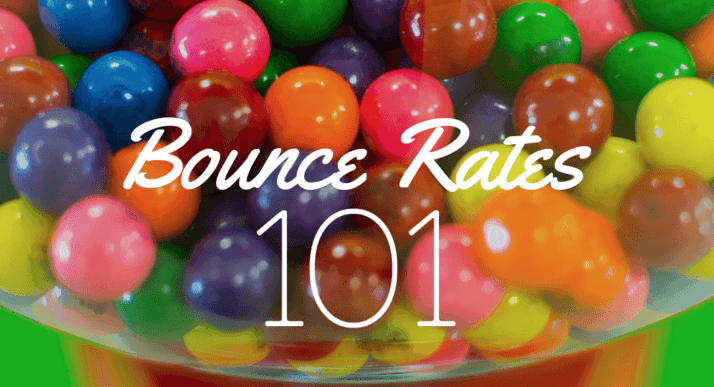Of all the statistics in a Google Analytics account, the concept of “bounce rate” can be the most misunderstood.
Different websites might aim for different bounce rates. And figuring out why a bounce rate is high can take a little bit of detective work. But analyzing and understanding your site’s bounce rate can go a long way towards diagnosing which parts of your site are successful—and which ones may need more work.
This guide will walk you through what you need to know about bounce rates, and what you can do to improve the bounce rate of your site.
What is a bounce rate?
“Bounce rate” refers to the percentage of single-page sessions on your website. A “single-page session” means a person visits your website and then leaves your website from the same page they visited. For example, a person visits your homepage and then leaves without navigating to any other pages on your site.
It’s essentially the same as a person coming to the window of your store and then walking away without actually coming in. If you have an 80% bounce rate, that means 80% of people who glance at your storefront leave without entering.
Bounced visitors often fail to continue through the sales funnel and leave before completing a desired action—before converting. For most websites—excluding single page sites—the lower the bounce rate, the better.
Where can I find my site’s bounce rate?
If you have Google Analytics set up for your site—and if you haven’t set up this free tool, the time to do so is now—finding your bounce rate is just a few steps away. To begin, log in to your Analytics account. By default your bounce rate will be displayed in the basic Audience — Overview tab:
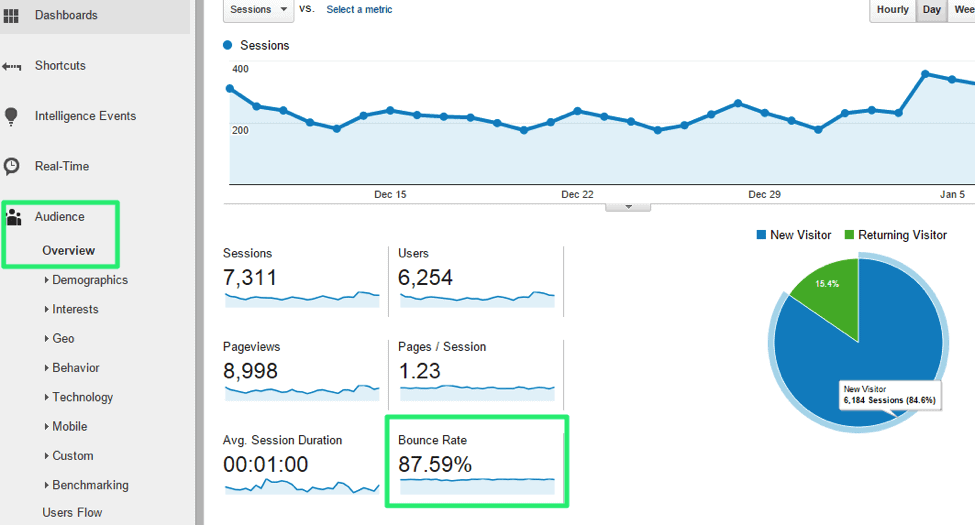
This view is basically like a stethoscope for your website’s vital signs. In the example above, the bounce rate is very high. Because it’s for my personal blog, it can probably best be explained by visitors who land on an article, read it, and then go back about their business.
The bounce rate displayed in this overview is actually site-wide. If we want to know the bounce rate of a specific page, we need to navigate to Behavior — Site-Content — All Pages:
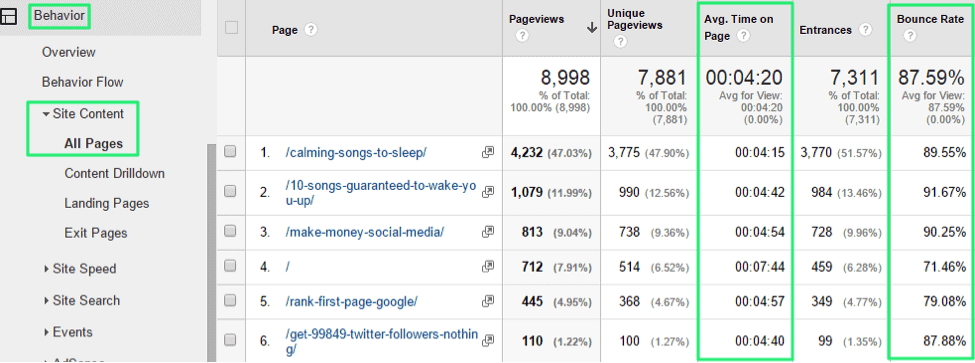
This is how I can tell that visitors actually spend a good amount of time reading individual articles before leaving—a little over 4 minutes on average. Therefore I’m not too upset about my bounce rate, since people are reading my articles. But I could probably do more to encourage them to stay on my site and keep reading other pieces.
What is a good bounce rate?
Don’t be alarmed if your bounce rate is higher than expected. Remember, a bounce rate of 0% means that every single visitor visits additional pages before leaving your website, 50% means 1 in 2 is leaving and 100% means that every person that visits your site leaves before visiting another page. A ‘good’ bounce rate is subjective. If you have a lot of traffic and a 70% bounce rate, then reducing it to 65% could be a pretty substantial increase in revenue.
If you just want to get a sense of average bounce rates, check out the graph below from RocketFuel:
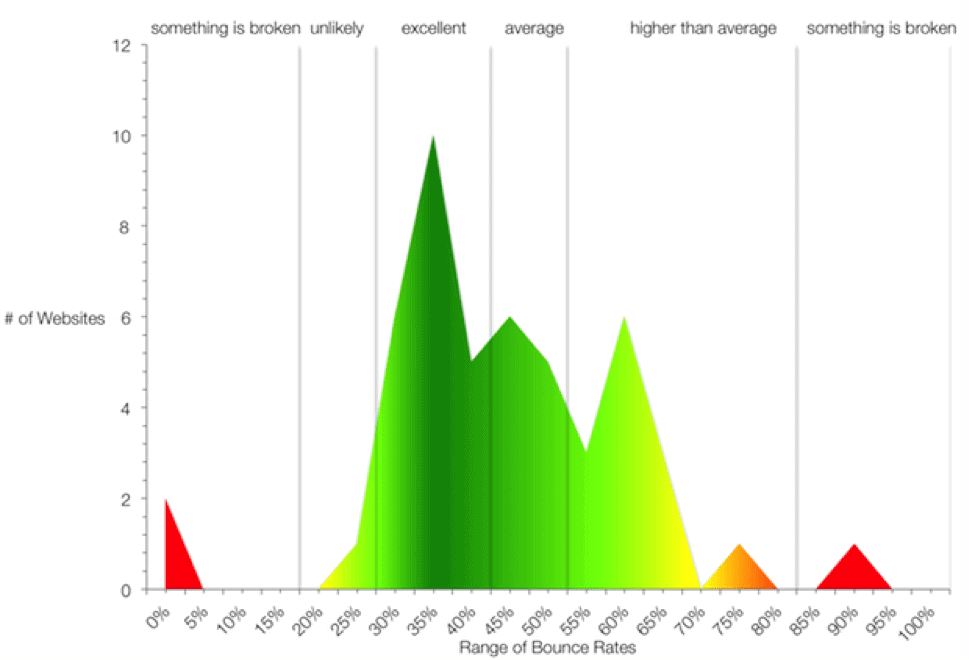
For general reference:
- An ‘exceptional’ bounce rate is in the 26-40% range
- A ‘good’ bounce rate is in the 41-55% range (the rough average)
- An ‘okay’ bounce rate is in the 56-70% range
- Anything over 70% needs attention
Remember, this is just a general reference guide. Different types of websites will have different averages. News and blog sites, just like my own, can have much higher bounce rates because someone will simply read one article and then move on. An eCommerce platform or digital catalog should naturally have a lower bounce rate because visitors are browsing and comparing multiple products on different pages.
Set your own goals for bounce rate by determining the conversion value of your page in question. Specifically, if you reduce the bounce rate by 10%, how much of a revenue boost will that result in? Keep your goals realistic.
Why is my bounce rate so high?
Higher bounce rates can be caused by a number of factors:
- A single page website. If your entire website is one page, there’s no way someone could leave that page to go somewhere else while remaining on your site.
- Broken analytics. If Google Analytics isn’t correctly embedded in your site, your rate could be higher than expected. Google has listed a few steps you can take to ensure you have correctly implemented their free Analytics software.
- Site design flaws. A few tweaks—outlined below—could lower your bounce rate.
- Poor instructions or calls to action. If it’s not clear what should happen next, or where a visitor should go, the desired action probably won’t happen.
- General usage. Depending on how users interact with your site, your bounce rate could be high—if the majority of users come back often and have the site bookmarked to a specific page, like a blog page, each visit counts as a bounce to Analytics.
There can also be a few instances where a high bounce rate isn’t necessarily bad. For example, you might have a landing page with your phone number in a big bold font, accompanied by urgency to call the number. The page could be effectively converting visitors into callers, but the bounce rate will be high because no one is going to any other pages. The bottom line is that even though bounce rates are important, they don’t tell you everything.
Determining what’s affecting your bounce rate
Now that you’re starting to get the gist of bounce rate, let’s take a look at some approaches to uncovering practical insights about our own bounce rates and actually improving them.
1. Look at the bounce rates for each page
Check out the various pages of your website inside your Analytics account. Remember that you can access this information in Google Analytics by navigating to Behavior — Site-Content — All Pages. If you like to stay organized consider opening a spreadsheet and recording the URL of every page with a high bounce rate that has value respective to your business. You might have 20+ pages with high bounce rates but only two or three actually work to convert visitors. Address those first.
2. Look at the bounce rates for each traffic source
In Google Analytics, navigate to Acquisition — All Traffic — Source/Medium.
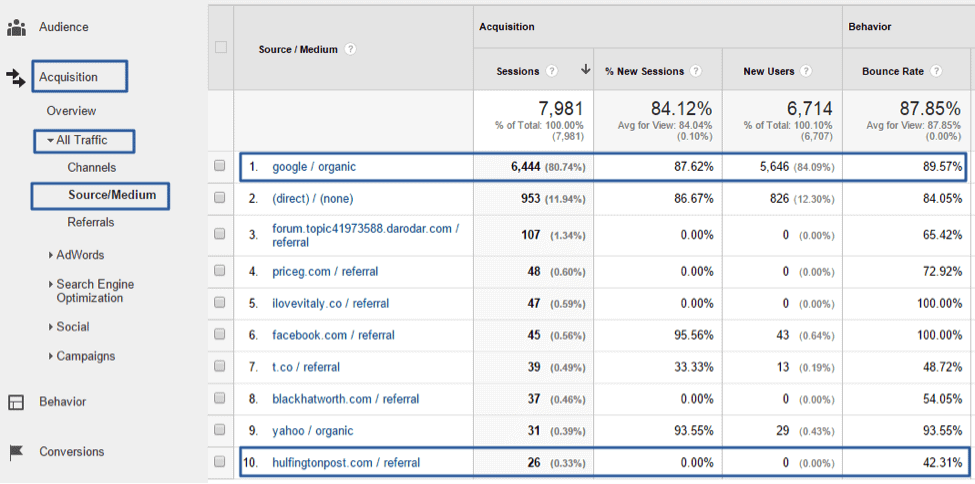
Looking at the bounce rates from different sources can help determine where you should invest more time and energy. In the example above, the majority of my traffic is organic and coming from Google, but the bounce rate is pretty high, while referrals from Twitter and The Huffington Post have much lower bounce rates.
In other words, those referrals are reading more than one article, while the organic searchers are just browsing the article they searched for and moving on. This information can help you see where you should focus your efforts and where your “good” traffic is coming from. You can get these insights just by comparing the traffic sources and bounce rates.
3. Perform a routine check-up on page timings
In Google Analytics, navigate to Behavior — Site Speed — Page Timings.
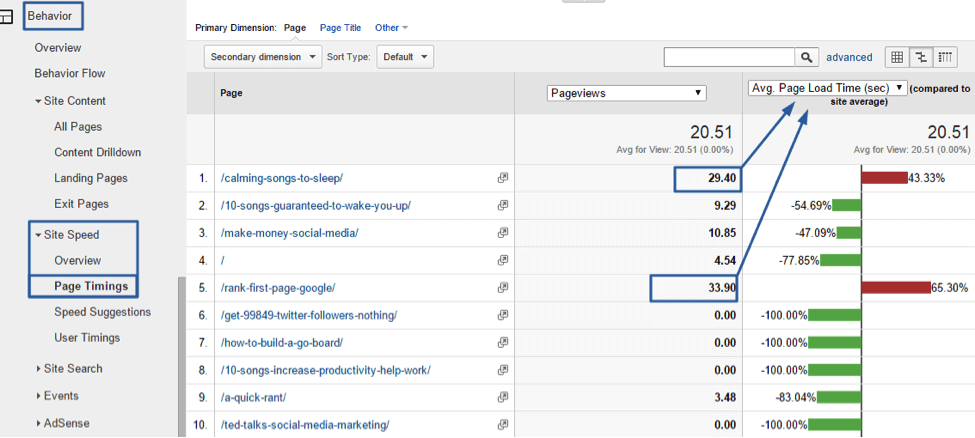
Pages with excessive loading times will try your visitors’ patience, and they are often the primary cause of high bounce rates. You want your site to load quickly regardless of connection or device. Navigate to Speed Suggestions in the Site Speed tab to find out suggestions for improving page speed:

How to keep visitors on your site longer
When page speed is not an issue but bounce rates are high for pages that you want to improve, consider the following approaches:
1. Take a look at your website design
As mentioned before, site design flaws can negatively impact bounce rates. This is one of the easiest places to make a few changes that could lead to mega results. Areas of focus should include:
- Ensuring your navigation is clear. If your site leads to confusion, or if a user isn’t sure of where he or she should go after landing on your site, it’s likely to result in a bounce. Make each piece of information easy to find.
- Include calls to action on each page. Just in case a visitor arrives on a page that’s not your homepage, there should be no question of what should happen next. Include signup forms on each page and drive visitors to your sales page at every opportunity.
- Look at the formatting of each page. Is the text clear and easy to read? Are your paragraphs short? Do pages require little to no scrolling to find all the information needed to proceed? If any of these questions receives a “no” for an answer, it’s time for a change.
2. Tell a story
Storytelling, such as company history, a recent event or press release, and even a mission statement are effective ways to entice visitors. It helps your brand move from a bland storefront into a business with personality.
Consider using different, connected pages inside of your site to allow users to learn about your brand, your employees, your customers and what you stand for. Consider implementing stories in the form of a blog or page and including calls to action at the end of the post that works to convert readers.
3. Eliminate unnecessary information and distractions
Look for things that might detract from your intended message—like autoplaying videos, extra photos, or third-party ads—and content that doesn’t add value. Cut them out. You want your site to be focused on the end goal, keeping the attention of your visitors and directing them toward conversions. Anything that doesn’t do so is likely increasing your bounce rate. Try comparing your landing pages with the benchmarks from GoodUI for a cleaner and user-friendly approach.
4. Rethink content with bonds of relevancy
Some of the most heavily-used websites are great examples of how to set up pages and content with bounce rate in mind. Wikipedia, for example, has every page interlinked with bonds of relevancy. We can easily go on tangents from our main topic, like cars, and end up learning about different makes and models. Our websites should follow suit and ensure every page is relevantly linking to internal pages whenever possible. This provides more opportunities for visitors to navigate around, reducing bounce rate, and keeping their interest .
When approaching problems with your bounce rate remember that everyone has their own goals. A high bounce rate can be fine if the page is the only/last stop in the conversion funnel. Also remember to stay organized and record the pages, problems, and considerations you encounter. This will help you manage bounce rate issues efficiently and keep visitors more engaged in the future.

